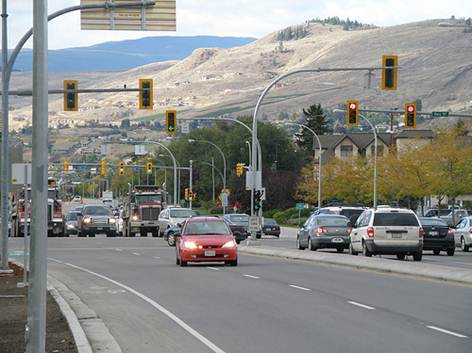
[This blog was last updated on Feb. 24, 2022]
What makes traffic light signals change?
Green.
Yellow.
Red.
Green…
Traffic signals are Intelligent Transportation Systems (ITS) designed to allow vehicles to safely cross paths while maintaining an efficient flow of traffic. To do this, traffic signals react to the presence of the vehicles and pedestrians they are guiding.
Although you probably don’t notice it, each mode of transportation interacts with traffic signals in a unique way. Here are the five main traffic light triggers.
1. Passenger vehicles and bikes
Ministry of Transportation and Infrastructure intersection traffic signals are “semi-actuated,” which means the signal will rest green on the highway until a vehicle on the cross street or in a left turn bay sends a callout for its own light to turn green. There are various vehicle detection systems out there; the ministry uses a wire embedded into the pavement and connected to the traffic signal controller. Because the wire forms a large circle, these detectors are commonly called “loops.”
When a vehicle drives over the loop, detector hardware senses the change in electromagnetic field caused by the presence of metal (from the vehicle) and a request for a green light is queued. The signal will “serve” green lights to waiting vehicles in a predefined sequence.
While an approach has a green light, the loops continue to detect vehicles, which extends the light up to a predefined maximum time. The maximum time ensures that the light continues to cycle, giving everyone a turn. The only exception is when there is a green light on the highway and nobody waiting at any of the red lights. Even if the highway green light “gaps out” or “maxes out,” the signal will stay green on the highway until someone shows up at one of the red lights and needs service.
Engineers constantly monitor the provincial signal network to keep things working well.
2. Emergency vehicles
Have you ever noticed those small white and blue lights perched on a traffic signal beam? They may not mean a lot to you, but they do to emergency vehicles.
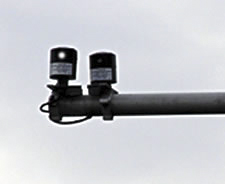
Many traffic signals are equipped with an emergency vehicle pre-emption device, which allows emergency vehicles to activate a green signal in the direction they are travelling. The most common ministry pre-emption device is triggered by the sound of the emergency vehicle’s siren. That’s when the white and blue lights come into play.
Since multiple emergency vehicles may approach an intersection from different directions at the same time, one direction is given priority. The white light indicates pre-emption granted in that direction of travel, while the blue light indicates the intersection is being controlled by an emergency vehicle approaching from another direction.
3. Pedestrians
Most intersections include pedestrian “walk” signals that indicate when it is safe to cross the road. Pedestrians push a button, which sends a signal to the traffic controller calling for a green light in their direction along with the pedestrian walk symbol.
While it may take time for the green to activate at an intersection, traffic signals at enhanced pedestrian crossings (like the one pictured here) react immediately by activating flashing lights next to the roadside and/or overhead pedestrian signs. This alerts oncoming traffic to slow down and yield to crossing pedestrians.
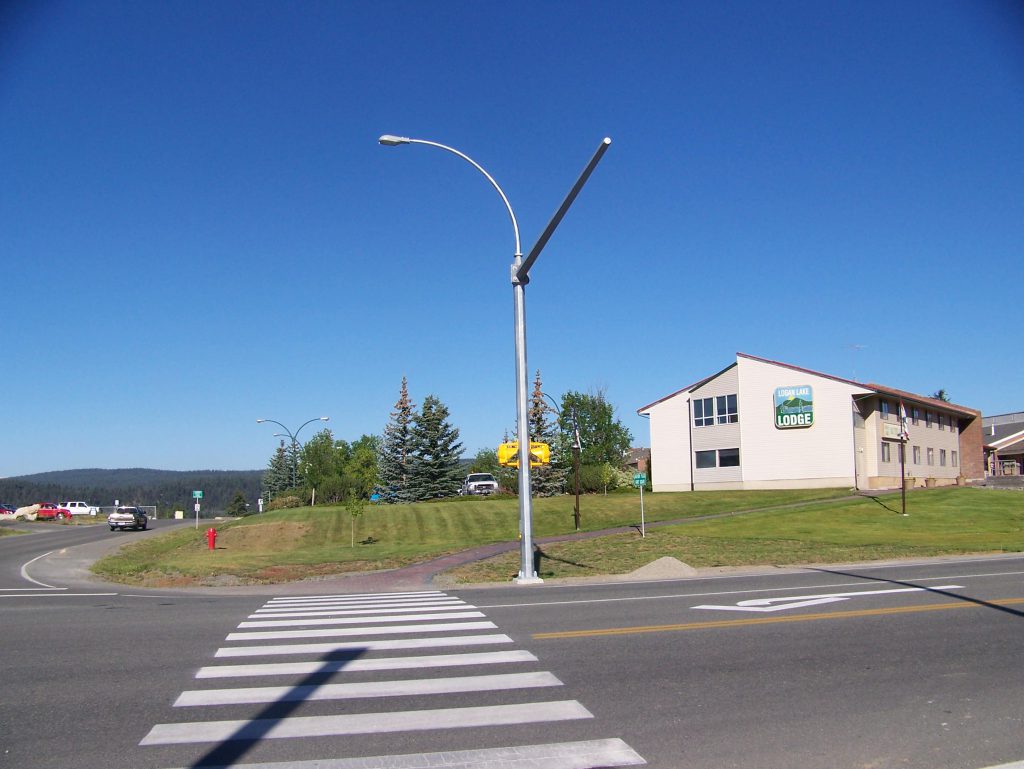
4. Buses
We all have daily schedules to follow; but on the road, it’s tough to find a stricter driving schedule than a public transit bus driver’s. Transit users rely on buses reaching their stops on time.
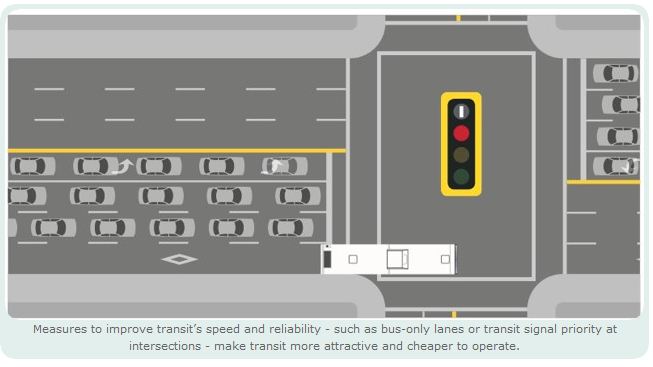
Bus lanes are not the only things that help buses maintain a consistent schedule – buses have their very own traffic signal, too. Some traffic lights include a rectangular white light at the very top that allows buses to proceed through the intersection ahead of other vehicles. Remember those actuated loops for passenger vehicles we mentioned earlier? Buses also have them; only difference is they cover more ground so that smaller vehicles cannot trigger the signal.
5. Trains
Ever wonder how railway crossings on roadways are activated? As a train approaches a crossing, it sets off a sensor built into the track, which prompts the rail crossing lights to flash. When an intersection is nearby (60 metres or less from the tracks, to be exact), a green light activates for vehicles closest to the tracks, allowing these vehicles to safely clear out of the vicinity of the rail crossing. The rail crossing lights flash for a minimum 24 seconds before the railway gate slowly lowers. The gate is completely closed five seconds before the train arrives.
So, there you have it: five ways traffic signals turn from green, yellow, red, and back to green. They’re pretty smart. Next time you’re waiting at a red light, don’t fret, it knows you’re there. You’ll be back on your way soon.
If you liked this blog, check out these other popular posts:
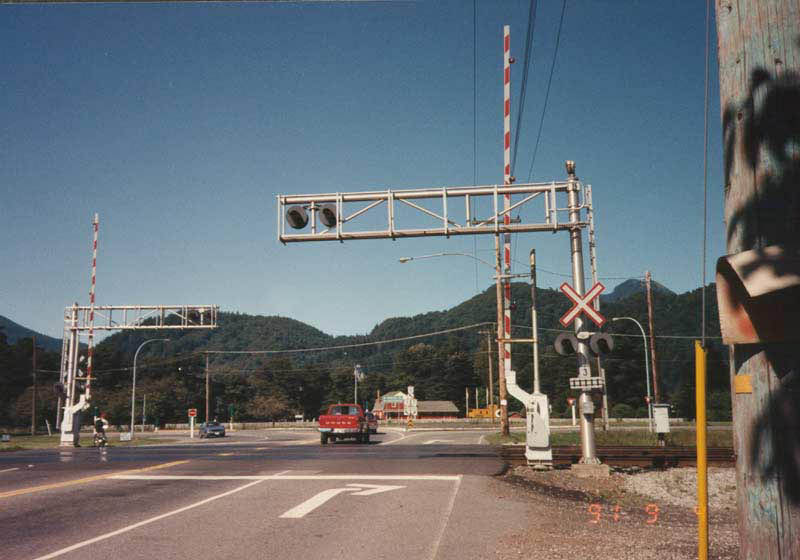
Hi
we live in Quail Ridge and head to the airport quite frequently as my husband works there. The light that crosses the highway from our area is way too short and most times a line up of 5 cars takes two light changes. Could we extend the time on this light? This is the light at Highway 97 (Heading North) and Airport Way light that leads us toward the airport.
Hi, Rhea.
We would suggest using DriveBC’s report a problem tool to connect with the electrical maintenance contractor for your area directly about this: https://www.drivebc.ca/rahp/
Thanks for connecting with us.
Hi
I live in kelowna (rutland) near hwy 33 and gerstmar rd and there really needs to be a left had turn signal heading into town on hwy 33 (east I think) people are always trying to turn and there is a turn lane there. it’s painful to see 0 to 1 cars get through every cycle or 2. many people cut through the shell station its more convenient.
Hi Sue, thank you for connecting with us here. We have passed your comment along to staff working in the area. If they reply with any further information on the intersection we will be sure to let you know here. Thanks again for letting us know.
I’ve heard that optical sensors are also used to trigger signal changes. Are these only used in municipalities and not on MoTI highways?
They look sort of like camera but smaller than the BCHwyCams.
Hello Ron,
Thanks for your question. These cameras are not currently in use on BC Highways. We encourage you to connect with local municipalities to confirm their use. Hope this is helpful. Safe travels.
Vehicle loops work well mostly. But I drive a large motorcycle which is mostly aluminum. I have had problems trying to enter a highway safely on a light controlled intersection because the loop doesn’t see me. The particular one that I recall is at the top of peden hill in pg. Traffic is directed this way to go west on highway 16 from the large homedepot mall.
Hi Jim – thanks for your comment. Sometimes, our electrical engineers are able to increase the sensitivity of loops to detect vehicles with less metal (such as your motorcycle). If you reach out to the closest area office with your concerns, they may be able to have staff look into it for you. For the Prince George area, the contact is below:
360, 1011 – 4th Avenue
Prince George, BC V2L 3H9
250 565-4410
In Fort St. John on the Alaska highway, if you are headed north on the highway and turning left onto Old Fort road the advanced left light quickly changed to amber before a commercial truck, who was first in line, can get his front number through the intersection.
Hi Chris,
Thanks for connecting with us here. We have shared your comment with our staff in the area and can confirm that the Fort St. John office will undertake a review of the signal timing at this location and make adjustments if warranted. For further information, you can reach out to your local MoTI office at 250 787 3237. Thanks again and safe travels.
Thank you for the informative article!
I have noticed the white and blue lights but emergency vehicles still have a long wait at the signal lights. Is there another way that gets the traffic moving like a remote signal changer that emergency personnel can use?
Great question Jaqueline – unfortunately we don’t know of any other signal devices that might be used. Perhaps the BC Ambulance Service would know? Here is their contact information: http://www.bcehs.ca/about/who-we-are/bc-ambulance-service
If they determine that there is a need for different devices to manage traffic during an emergency event via traffic signals, we would work with them to accomplish this. Hope that this information is helpful.
Is it possible that during an emergency vehicle passing through a set of lights with its lights flashing and siren on to have both sides of lights turn green after it passes? Could the timing be off? I had a green arrow and green light at the corner of Academy and Main Street in Auburn and I was told that the lady who hit me had a green light.
Hello Lucie – thanks for your question. Unfortunately, we can’t think of any instance, except for a technical error where this might occur. We encourage you to follow up with your local authority in Auburn, as we are a Canadian authority. Hope that this helps!
i am programming stop lights for my tech class. How long does it take for a light to change one activated eith these 5 thing?
Hi Anne,
We aren’t sure we understand the question? How long does it take for a light to change once activated with these 5 things?
Are there any regulations regarding the timing and operation of traffic lights? More specifically the timing from green to red regarding the lights on highway 3 in cranbrook.
Good morning Donovan – we can connect with local staff to review – is the light taking too long to turn?
They’re turning way too fast for a major truck route. If a truck is stopped at the light only one gets through before it turns again. And it only stays yellow for around 4 seconds which isn’t nearly enough time for a truck to clear the intersection.
Hi there – thanks for your comment. Do you know the location of this light? Once we know where exactly, we can have our electrical team look into timing.
Almost all of the lights along highway 3 through cranbrook do it. Highway 3 and king street seems to be the worst one though.
Hi there Donovan – we reached out to our local area manager who confirmed that all of our lights are are timed based on engineering standards which include review of number of vehicles and training movements. Timing is verified and signed off by our traffic engineers, monitored by our electrical engineers and audited by our electrical centre. At this time, all of our lights on BC Highway 3 through Cranbrook are functioning as they should be.
The traffic lights under Vanguard drive Bridge at coco cola need to be changed back to its original operational programmer because currently the automated traffic lights signals are uneconomical for current drivers.
Hi Graeme,
Thanks for your comment about the timing of lights.
I am having difficulty understanding what location you are referring to. Is it Vanguard Road, in Richmond? I checked Google Maps and see that the Coca Cola bottling plant is at Vulcan Way and Viking Way. You may wish to connect with the City of Richmond, which would be responsible for roads in that area: https://www.richmond.ca/contact/departments/epw/roads.htm
If this is not the area you are referring to, then please provide further details about where in BC this is, or the names of the cross streets near Vanguard Road/Bridge. (I’m based in Victoria and respond to comments from across the province).
Thanks!
Quick question for you,
So does this mean every/ALL intersections are controlled by 1 of these 5 ways? What if there is no “loop” at an intersection? Would it be timed?
Specifically the intersection on Canada Way and Sumner Street in Burnaby BC. If there is no “loop” and there were no pedestrians at that time crossing, how would the light change ?
Hi Lisa,
If there was no loop and no pedestrian to activate it, the signal would be on a timer. Hope that this helps!
Thank you for answering all these questions. I have a traffic light on my route to work that seems to have changed. It’s a left- turn light and it appeases to have been shortened in duration. This has caused a major back-up in the left turn lane, and instead of getting through the light in a few minutes, it now takes ten minutes it more- about 5 light change cycles. The cross traffic is not heavy and there were no back-ups anywhere in either direction until this change. Is there any way to get my city (Abbotsford) to look at this? I drove this route for 7 months with zero issues until last week. Now it’s backed up 20 cars or more every morning. It’s a left teen lane that originated at an exit off HWY 1, so now people are getting stuck or having to zip around the left-turn lane traffic to reach the through lane. Others are resorting to trying to butt into the line of cars closer to the light, blocking the lane and causing drivers to move around them. It’ seems like a pointless change to me!
Sorry, my autocorrect went a little crazy there!
Hi Tammy. Can you please specify what exit you are referring to?
Hi,
The system that is used for emergency vehicles is based on siren as per this website. I wanted to know which other type of system for emergency vehicles are used and in which country are they used ?
Hi Yash,
Thanks for connecting with us here. Unfortunately, we don’t have the information, but suspect you could ask at a local fire hall, or search online for more information. Hope that this helps!
hi
i have a new truck now, a 2011 toyota tacoma, and the truck does not trigger the loop. i showed my landlord and he says he never saw anything like that in 50 years he lived there and crossed over with many different cars over the years. my old truck used to trigger the loop just fine but with my tacoma i am standing there for ever, till someone on the othetr side shows up and triggers the loop there. i called the railway problem number but they couldn’t help me. only hing i can do, is to drive over the tracks wait at the edge to a main road and wait there. it works then but it is dangerous and i would rather not do it.
Hi Marlon,
Could you tell us which intersection you are having this issue at?
Hi there
I have noticed some years ago that every traffic signal controlled intersection in the city of Burnaby has a pole (or several) on top with a diamond shaped plate on it (see pics referenced below) and I have yet to find anyone who can positively identify their purpose – the best guess I have heard thus far has been that these are part of some emergency vehicle pre-emption devices, however after reading the article above I see that such devices look quite differently and seem to have a light on them…. could someone please solve this mystery for us and tell us what those things are?
Thanks in advance for your help….
https://www.facebook.com/photo.php?fbid=10157489240140080&l=40336854ad
https://www.facebook.com/photo.php?fbid=10157489245935080&l=fdad2a1c76
https://www.facebook.com/photo.php?fbid=10157489247490080&l=4a097cfe10
https://www.facebook.com/photo.php?fbid=10157489250015080&l=bb3b8bfdc8
Hi Zig Zigler,
Thanks for your question about the devices in Burnaby. As these diamond-shaped plates are mounted on traffic controls in the City of Burnaby, I suggest you contact their administration for information about the devices. Burnaby’s website has a number for their roads department – 604-294-7460. There is also a feedback form where you can ask questions: https://www.burnaby.ca/Our-City-Hall/Contacts-and-Location.html
Those rectangular boxes are microwave vehicle detection. In lieu of cutting the pavement to put traditional loop detectors, the signals are actuated by the detection of present vehicles using microwave technology. This way a bicycle or motorcycle could actuate the signal as a vehicle would.
How far back are the “loops” located from the limit line? We teach our drivers to stop about 15 feet back from the line for space cushioning safety purposes. The concern will be that this will be too much room and the light will not be activated.
Thanks,
Hi Catherine,
Typical ministry signal loops are installed in pairs, with the first loop at 0.1 m from the back of the stop bar, and the second loop at 3.0 m behind the first. Each loop is approximately 2 m long. Activation of the signal comes from detection on either loop and therefore a vehicle should stop no less than 5 m from the stop bar to ensure adequate detection, so stopping 15 feet back should not be a problem. Hope that this helps!
I like what Mexico does with their traffic lights. Before the light turns yellow, it flashes green for a few seconds. I find there is less people slamming on their brakes when they see a yellow light. The flashing green lights give advance notice that the light is going to turn. Here, if no one has activated the crosswalk, the yellow light always becomes a surprise.
This makes no sense. The yellow light’s function is to give you advance notice that the light is going to turn red. There’s no need for an advance notice to the advance notice.
does the lights actuate when you flash your lights high beam to low beam and back and forth fast to resemble a emergency vehicles flashing lights and is it against the law to do so .Please could you reply with and answer to this question so I can tell my associates the lawful answer.
Hi Gilbert,
Thanks for connecting with us here. For those of our traffic signals that have it installed, our signals enter an emergency vehicle pre-empt sequence in one of two ways:
1) Hardwired to a fire hall and activated by push button by the fire hall staff, or
2) Sonic pre-emption which by using a “horn” detector on the signal poles of our signal, captures the “siren” of the emergency vehicle admitting it along the highway approach the emergency vehicle approaches on.
So, to answer your question simply, flashing your lights from high to low beam really quickly won’t change the light. Hope that this information helps.
I am trying to find out who to make a complaint to about, the traffic lights for pedestrians, why is it only 6 seconds, some crossing are longer and some smaller, 6 seconds is not enough time to get across. this is not acceptable, who’s dumb idea was there, really why that stupid hand come up , what do they want you to do stop in the middle of the road!!!!! fix this!!!
Hi Cindy,
Sorry to hear your frustration – could you tell us the location of the light causing you concern? If the crosswalk is under our control and the time allowed to cross the street is not enough, our traffic engineers can review and adjust times. A bit of pedestrian crosswalk background information for you – there are three types of pedestrian indicators:
1. The Walking Man indicates you can begin to cross the road, by stepping off of the curb and across the crosswalk. The length of time you see the walking man considers a pedestrian’s perception-reaction time to recognize you may cross and start moving across.
2. The Flashing Stop Hand means you should not begin to cross the road, because there isn’t enough time left to cross the entire crosswalk. But, if you’re already in the crosswalk, you can continue to cross.
3. The Solid Stop Hand signifies you should not be in the crosswalk, as vehicles may be crossing paths.
Hope that this helps!
I wonder whether the ministry ever remembered to use actuation systems on the main roads too, where only the side street has push buttons and loops or radar or whatever. If A detection system finds low volumes on the main road and no buses or emergency vehicles that would justify delaying the green for the side street, why not trigger the yellow light immediately (there would also be a system to find out whether a pedestrian has pushed the button to cross the minor side road), then go to red, all clearance interval, then green for the side road. And why not have the system of loops and pushbuttons used to allow the side road and main road the maximum movement, for example when you have a major road, side road, and a protected permissive signal for left and right turns in all directions, and pushbuttons for actuating pedestrian crossings, and loops for autos and bicycles, and if the pedestrian does not push the button but the loops go off, then a protected right turn could be used.
Hello Robert and thanks for connecting with us here. What we think you are asking is “why can’t some of our signals be ‘snappier’, particularly those on side streets. Here’s the reply we received from our traffic engineers:
The ministry uses actuation on both side streets and the main highway for all signals. Detection loops on the highway are typically placed both at the signal and upstream so that we can ‘see’ approaching vehicles. However, there is a limit to how far we can continue to see.
Given that there is usually much more traffic on the highway than on a side street, we often, as you have noted, delay the green for the side street by a few seconds. This strategy favours the majority over the minority and reduces driver frustration for highway users as they won’t see the situation where a lone vehicle rolls up to the stop bar on a side street and the highway green immediately shuts down (which is very frustrating and inefficient).
A typical ministry signal uses a system of around 20 loops to help achieve the most efficient operation of the signal possible.
Pedestrian push buttons are used at ministry signals on the cross street so that pedestrian timing is given only when a pedestrian is actually present (more efficient).
Hope that this helps!
Thanks for your reply. My husband and I disagree on this subject so I still need further clarification. When the pedestrian lights are activated the through traffic is stopped by the red light. My husband turns left into the intersection at this point and waits before the crossing. When the pedestrians have crossed he waits for the light to turn green before he proceeds … this means the light is green for the through traffic. I think he should proceed through the red light when the pedestrians are safely across. Can you say which is correct.
Thanks.
Hi again Yyvonne,
A driver should move through the intersection when it is safe to do so. This means they should not sit in the intersection if they are clear to move as they could hold up traffic moving on the new green light. Hope that this helps. It’s not everyday we can help settle a husband and wife disagreement! 😉
If turning left from a side road at a t junction, can I proceed into the intersection when the red pedestrian light is activated, then move through the red light when the pedestrian has crossed, or do I need to wait for the light to turn green. There is no light on the side road.
Hi Yvonne,
You can turn left only when the pedestrian has crossed and it is safe to do so. Hope that this helps!
http://www.icbc.com/driver-licensing/Documents/drivers4.pdf
A friend and I recently took a trip to Vancouver from Oregon. She was the driver and I, the passenger. At a major intersection, there were numerous red lights but when she began (with the rest of the traffic), it looked to me to still be red. Are the lights configured to only be seen accurately head-on from the driver side of the car or was I perhaps seeing a different light for a right-hand turn lane. I am perplexed.
Hi Shannon,
We put “louvers” around our signal heads so they are primarily visible to the traffic in the lanes they are directing. For our left turn only signals, which are likewise protected by louvers, we use an illuminated red circle. In the U.S., there typically is a red arrow for this situation.
From your position in the passenger seat, you may have been seeing a red left turn only signal, while the driver was seeing the green signal directly ahead.
I only moved to BC in 2007, so I was a bit surprised to meet all the loop-activated traffic signals in use everywhere out here. I guess they don’t hold up so well in the ultra-cold of an Alberta winter with plows scraping the road and all.
Anyway, I do have a beef with the loop-activated signals – they should fit into a “green wave” type system. Far too often, I get up to speed from a light on a highway, and a vehicle on a side road triggers the next light causing me to have to brake and stop. This usually happens because there is no traffic on the main road keeping the loops there activated. Additional loops should be placed further from the light on the main road as well to handle the approaching high-speed traffic.
Instead, I think that the traffic on the side road should have to wait until a short time before the light cycles to allow that traffic to proceed. In the long run, I think that a small number of cars idling on the side road would produce less greenhouse gas emissions that those that have just gotten up to speed, and been forced to stop, and then accelerate again.
HI Brian,
Thanks for your suggestions. We actually do employ some of these techniques on the traffic signals on Vancouver Island, however throughout the rest of the province, we don’t use them much. The reason is, when travellers move from town to town in BC, there’s not much development between them so there is seldom the need for employing signals outside of city limits. Use of the “green wave” depends a lot on signal spacing, the number of signal phases and the traffic composition and the travel speed. Within municipal boundaries most of the signals would belong to the municipality and the operation of those signals falls upon the local government to operate their signals as they deem fit.
For those signals that do belong to the Ministry within city boundaries, some will be coordinated while others will not. Even when coordinated, perfect coordination is difficult to achieve as the best coordinated systems will have (and this type of set-up is rare):
� All intersections have the exact same traffic volumes on each of the legs of the intersections
� Spacing between signals is the same (200 – 400 m)
� Lane configurations are the same (all have the same amount of through lanes, left turn lanes, and right turn lanes)
� Signal phasing is all the same (same arrows, etc.) on all the legs
� The coordinated street is a one-way street
Hope you found this useful.
l would like the signals changed on HWY 41 road 415 changed so no one else has to go on a head on collision as we did 4/15/23@ around 4:30p.m. (l was the passenger).
Hi Jacqueline – Could you provide a bit more information on the specific location of this concern? That will help us follow up with the right people. Thanks!